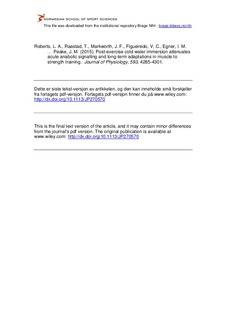| dc.contributor.author | Roberts, Llion A. | |
| dc.contributor.author | Raastad, Truls | |
| dc.contributor.author | Markworth, James F. | |
| dc.contributor.author | Figueiredo, Vandre C. | |
| dc.contributor.author | Egner, Ingrid M. | |
| dc.contributor.author | Shield, Anthony | |
| dc.contributor.author | Cameron-Smith, David | |
| dc.contributor.author | Coombes, Jeff S. | |
| dc.contributor.author | Peake, Jonathan M. | |
| dc.date.accessioned | 2016-08-30T11:25:16Z | |
| dc.date.available | 2016-08-30T11:25:16Z | |
| dc.date.issued | 2015-08-13 | |
| dc.identifier.citation | The Journal of Physiology. 2015, 593, 4285-4301. | nb_NO |
| dc.identifier.uri | http://hdl.handle.net/11250/2402781 | |
| dc.description | Dette er siste tekst-versjon av artikkelen, og den kan inneholde små forskjeller
fra forlagets pdf-versjon. Forlagets pdf-versjon finner du på www.wiley.com /
This is the final text version of the article, and it may contain minor differences
from the journal's pdf version. The original publication is available at
www.wiley.com | nb_NO |
| dc.description.abstract | We investigated functional, morphological and molecular adaptations to strength training exercise and cold water immersion (CWI) through two separate studies. In one study, 21 physically active men strength trained for 12 weeks (2 days per week), with either 10 min of CWI or active recovery (ACT) after each training session. Strength and muscle mass increased more in the ACT group than in the CWI group (P < 0.05). Isokinetic work (19%), type II muscle fibre cross-sectional area (17%) and the number of myonuclei per fibre (26%) increased in the ACT group (all P < 0.05), but not the CWI group. In another study, nine active men performed a bout of single-leg strength exercises on separate days, followed by CWI or ACT. Muscle biopsies were collected before and 2, 24 and 48 h after exercise. The number of satellite cells expressing neural cell adhesion molecule (NCAM) (10−30%) and paired box protein (Pax7) (20−50%) increased 24–48 h after exercise with ACT. The number of NCAM+ satellite cells increased 48 h after exercise with CWI. NCAM+- and Pax7+-positive satellite cell numbers were greater after ACT than after CWI (P < 0.05). Phosphorylation of p70S6 kinaseThr421/Ser424 increased after exercise in both conditions but was greater after ACT (P < 0.05). These data suggest that CWI attenuates the acute changes in satellite cell numbers and activity of kinases that regulate muscle hypertrophy, which may translate to smaller long-term training gains in muscle strength and hypertrophy. The use of CWI as a regular post-exercise recovery strategy should be reconsidered. | nb_NO |
| dc.language.iso | eng | nb_NO |
| dc.publisher | The Physiological Society | nb_NO |
| dc.subject | cryotherapy | nb_NO |
| dc.subject | adaptation | nb_NO |
| dc.subject | strength | nb_NO |
| dc.subject | anabolism | nb_NO |
| dc.title | Post-exercise cold water immersion attenuates acute anabolic signalling and long-term adaptations in muscle to strength training | nb_NO |
| dc.type | Journal article | nb_NO |
| dc.type | Peer reviewed | nb_NO |
| dc.subject.nsi | VDP::Mathematics and natural science: 400::Basic biosciences: 470 | nb_NO |
| dc.source.journal | Journal of Physiology | nb_NO |
| dc.identifier.doi | 10.1113/JP270570 | |
| dc.description.localcode | Seksjon for fysisk prestasjonsevne / Department of Physical Performance | nb_NO |
